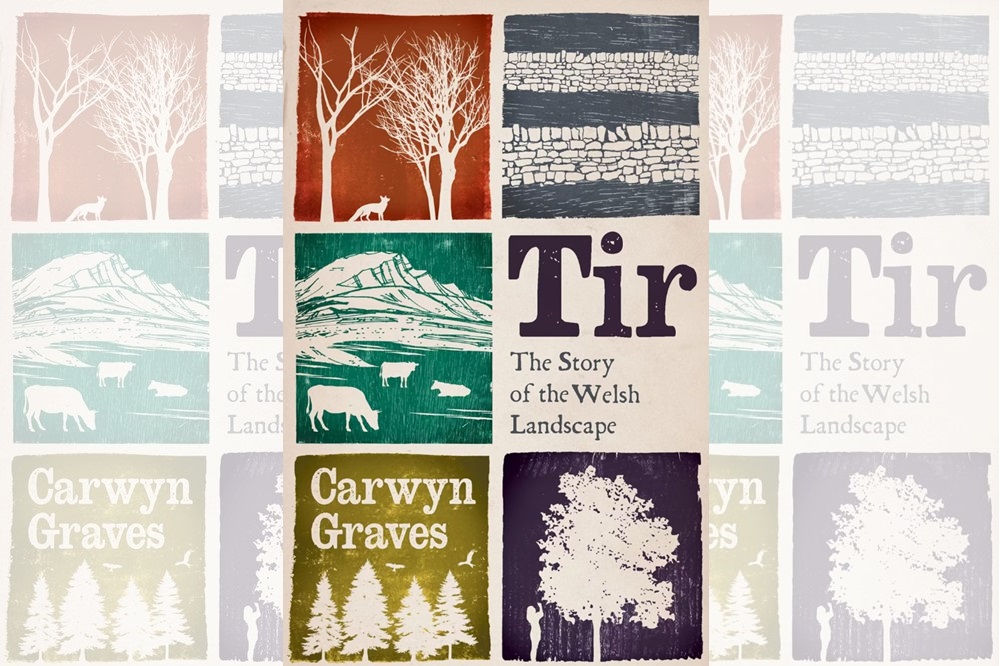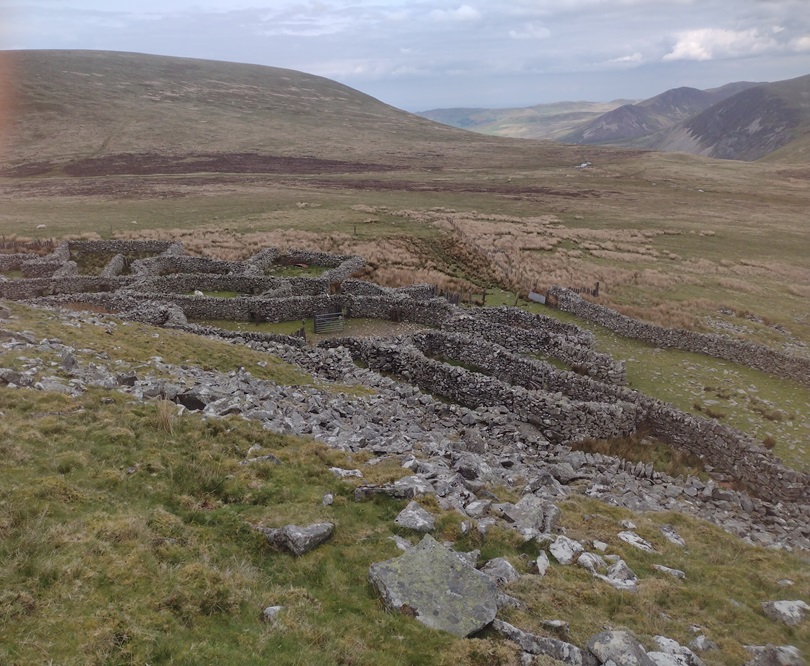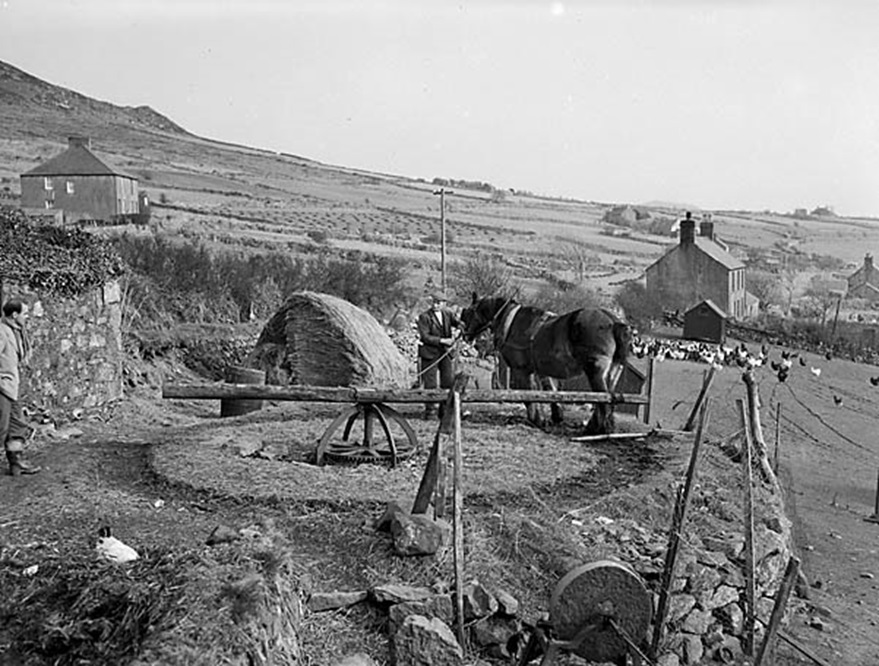Book extract: Tir – The story of the Welsh landscape by Carwyn Graves

Carwyn Graves
Hen Gymru fynyddig, paradwys y bardd,
Pob dyffryn, pob clogwyn, i’m golwg sydd hardd;
Trwy deimlad gwladgarol, mor swynol yw si
Ei nentydd, afonydd, i fi.
O land of the mountains, the bard’s paradise,
Whose precipice valleys are fair to my eyes,
Green murmuring forest, far echoing flood
Fire the fancy and quicken the blood
From ‘Hen Wlad fy nhadau’, national anthem of Wales
The golden sun of early autumn is warming our backs as we pick the apples in the old orchard of Cwmyrarian, a stone’s throw from the Tywi river in south-west Wales. My daughter munches a sweet one off the floor.
These dozen or so straggly trees with their red-and-green bounty are all that’s left of orchards on this farm that go back at least 200 years and used to be much more extensive. Kites are circling overhead, and some of the cattle in the next field are bleating impatiently.
We’re deep in the Welsh countryside here and so much about this semi-ruined place that was once a prosperous farm chimes with the complex history of the wider landscape in this country.
On the one hand, this beautiful country of Wales – Cymru – has a landscape as intimately known, cherished and stewarded as any in the Western world, with a unique, native culture that is umbilically connected to the land. Here, deep currents and stories place real value on community and all that is local, from ancient standing stones to farming tradition.
This is the home of the National Trust’s first property, one of the birthplaces of the Romantic rediscovery of nature and now of the pioneering Future-generations act. In Wales, as I’m reminded every time the national anthem is sung in sporting fixture or Eisteddfod meet, we pride ourselves on the beauty of the ‘Land’ of our fathers.
Deep roots
The land around Cwmyrarian is still farmed by a local family with deep roots here, and if I want to hear the tales that have been handed down about this place, the early nonconformists who secretly met near here and the old route across the river at low tide, there are still people in this community who can recount them.
Yet understanding the tale of the Welsh landscape is no easy task. Differing stories about the landscape run deep and, for centuries, have led to controversies of one sort or another. In many ways, the Wales of today is a blasted landscape: industrialized and polluted earlier than any other Western society.
Wracked by bad management and corporate power, it is now one of the most nature-depleted countries in the world. The Welsh landscape has also been despoiled in myriad ways by its governing authorities, resulting in everything from zombie conifer plantations to dead rivers and “sheepwrecked” hills.
The beautiful stone farmhouse at Cwmyrarian now lies ruined, the people gone, while the orchard it once supported has not only been neglected but even the orcharding heritage it represents has almost been wiped from memory and the historical record; a symptom of a wider malaise.

Diverse
But this small landscape that covers only 8% of the UK’s land area is enormously diverse in composition and contains in microcosm almost all the different sorts of habitat and terrain that exist across the British Isles.
Astonishingly, with 1467 out of a total of 1727 species, Wales has representatives of almost all the plant species present across the island of Great Britain as a whole.
Given how much further north Scotland extends, and how much nearer to the Continent much of England lies, the Welsh number is surprisingly high and betrays the range of geologies and microclimates that makes Wales Wales.
Such biological diversity may also reveal something about Wales’ land-use history, reflected also in the at-first-glance surprising fact that Wales has more than 20 times as much ancient woodland as nearby Ireland, and may have as many as the whole of France.
But whatever may be said about this profusion of plants and land-use history, there is clearly also an important riddle to be solved related to what has happened to Wales’ landscape over the past century or so of Cwmyrarian’s decline.
Despite the fact that there were fewer trees, smaller woodlands and a lot more industrial pollution in 1910 than now, overall levels of biodiversity as measured by bird and insect life were substantially higher.
SSSI
Over a quarter of Wales’ land area is protected either as national park or area of outstanding natural beauty, and well over ten percent of the land is now designated as belonging to SSSIs – sites of special scientific interest.
All these have come into existence over the course of the last seventy years, but the decline in wildlife has only accelerated over this period. The countryside now contains substantially less nature and substantially fewer working people than it did a century ago.
To everyone I have spoken to in the Welsh countryside, both these things feel like profound failures.
What has happened here? The broad contours of what has gone wrong may well feel familiar thanks to accelerating climate change and the slow death of the natural world, but as one of the first industrialized societies, understanding the specifics of what has happened to the Welsh landscape may well help bring out wider principles.
In particular, getting under the skin of both the death of some parts of the Welsh landscape and the reasons why other parts have remained in comparatively good health seems like an important question to ask in the early 2020s.
Musing on this question, it seemed increasingly clear to me as well that there was an important aspect to it that had hardly been touched upon in English, namely the cultural attitude towards the land and landscape contained and expressed within Welsh culture.
The second verse of the Welsh national anthem, reproduced above, may well at first glance reflect mid-Victorian romantic sensibilities, but scratch deeper at both this and the wider corpus of Welsh culture and you find an attitude towards the land that differs in notable ways from that of the dominant European cultures – whether English, French, German and others.
This attitude, I think, is an important part of the story of the Welsh landscape as it has developed, and I wanted an account of it to be a central part of the mix as I explored its human and ecological history.

Welsh landscape
To that end I am going to draw in this book on a broad and perhaps at times eclectic range of disciplines. I have travelled the country, mined libraries, stood in fruit-laden orchards and wet peat bogs and invited myself to farmhouses, historians’ offices and conservation sites to do this.
I have drawn on everything from ecological science to archaeology, myth and literature to explore the people and trees, the traditions and motivations that have shaped this homely and contested landscape.
As a result, this book is about many things, including farming and conservation, literature and ecology, nature and culture. But perhaps above all it is about how Welsh attitudes to nature and place allow us to chart the tale of the Welsh landscape from the inside.
There is, of course, no one essential ‘Welsh’ attitude to nature and the land that all inhabitants of the land share; but the distinct emphases we find in the record that has been deposited within Welsh culture for over a thousand years does contain a set of standpoints that may well have relevance for the future, and that matters.
I’ll argue that understanding the landscape without that nuanced cultural archive is next to impossible. Though I won’t do it full justice here by any means, language and culture contain the keys to any rounded understanding of the mechanisms by which this landscape has changed – for good and ill. And to that end, I want to start our tale by taking you back in time some seven hundred years…
Over coming weeks I plan to start posting a series of articles and reflections explaining more of where the book is coming from, and giving some detail on areas there was no space in the book to cover.
It’s available to preorder here, now. For details of launch events, sign up to emails on the website.
Support our Nation today
For the price of a cup of coffee a month you can help us create an independent, not-for-profit, national news service for the people of Wales, by the people of Wales.




